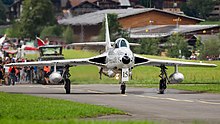Hawker Siddeley
Hawker Hunter F.6
|
|||||||||||||||||||||
|---|---|---|---|---|---|---|---|---|---|---|---|---|---|---|---|---|---|---|---|---|---|
.
History Hawker Siddeley Aircraft
Hawker Hunter F.6

The Hawker Hunter is a transonic British jet-powered fighter aircraft that was developed by Hawker Aircraft for the Royal Air Force (RAF) during the late 1940s and early 1950s. It was designed to take advantage of the newly developed Rolls-Royce Avon turbojet engine and the swept wing, and was the first jet-powered aircraft produced by Hawker to be procured by the RAF. On 7 September 1953, the modified first prototype broke the world air speed record for aircraft, achieving a speed of 727.63 mph (1,171.01 km/h; 632.29 kn).
The single-seat Hunter was introduced to service in 1954 as a manoeuvrable day interceptor aircraft, quickly succeeding first-generation jet fighters in RAF service such as the Gloster Meteor and the de Havilland Venom. The all-weather/night fighter role was filled by the Gloster Javelin. Successively improved variants of the type were produced, adopting increasingly more capable engine models and expanding its fuel capacity amongst other modifications being implemented. Hunters were also used by two RAF display teams: the "Black Arrows", who on one occasion looped a record-breaking 22 Hunters in formation, and later the "Blue Diamonds", who flew 16 aircraft. The Hunter was also widely exported, serving with a total of 21 overseas air forces.
.
Layout and structure

The Hunter is a conventional swept wing all-metal monoplane. The fuselage is of monocoque construction, with a removable rear section for engine maintenance. The engine is fed through triangular air intakes in the wing roots and has a single jetpipe in the rear of the fuselage. The mid-mounted wings have a leading edge sweep of 35° and slight anhedral, the tailplanes and fin are also swept. The Hunter's aerodynamic qualities were increasingly infringed upon by modifications in later production models, such as the addition of external containers to collect spent gun cartridges, underwing fuel tanks to increase range, leading edge extensions to resolve pitch control difficulties, and a large ventral air brake.
Late-production F.6s also featured an "all-moving tailplane", in which the entire tailplane pivoted to provide better transonic flight control. The elevator was retained as part of the all-moving tailplane.0
KmCeiling
0
KmCombat RANGE
0
Km/hAircraft Speed
0
Max Crew
Photo Gallery
Hawker Siddeley Aircraft
Hawker Hunter F.6


Hawker Siddeley Aircraft
Hawker Hunter F.6
General Info
-
-
-
- Crew: 1
- Length: 45 ft 10.5 in (13.983 m)
- Wingspan: 33 ft 8 in (10.26 m)
- Height: 13 ft 2 in (4.01 m)
- Wing area: 349 sq ft (32.4 m2)
-
-
Powerplant
-
-
- Empty weight: (6,406 kg)
- Gross weight: (8,051 kg)
- Max takeoff weight: (11,158 kg)
- Powerplant: 1 × Rolls-Royce Avon 207 turbojet engine, 10,145 lbf (45.13 kN) thrust
-
Performance
-
- Maximum speed: 623 mph (1,003 km/h, 541 kn) at 36,000 ft (11,000 m)
-
-
- 715 mph (621 kn; 1,151 km/h) at sea level
-
- Maximum speed: Mach 0.94
- Combat range: (620 km, 335 nmi)
- Ferry range: 1,900 mi (3,100 km, 1,700 nmi) maximum fuel
- Service ceiling: (15,000 m)
Armament
-
-
- Guns: 4× 30 mm (1.18 in) ADEN revolver cannon in a removable gun pack with 150 rpg
- Hardpoints: 4 underwing (7 hardpoints on Singaporean FGA/FR.74S, essentially refurbished FGA.9 derived from F.6) with a capacity of 7,400 lb (3,400 kg), with provisions to carry combinations
-
.
Links to Youtube & Others
Although in operational use, the Vulcan typically carried various nuclear armaments, the type also had a secondary conventional role. While performing conventional combat missions, the Vulcan could carry up to 21 1,000 lb (454 kg) bombs inside its bomb bay.
Hawker Aircraft
Hawker Hunter F.6
The Vulcan's only combat missions took place towards the end of the type's service in 1982. During the Falklands War.
Youtube Link
The missions performed by the Vulcan became known as the Black Buck raids, each aircraft had to fly 3,889 mi (6,259 km) from Ascension Island to reach Stanley on the Falklands. Victor tankers conducted the necessary air-to-air refuelling.














